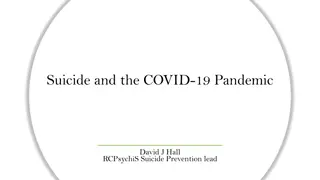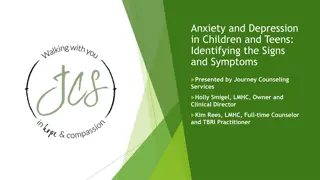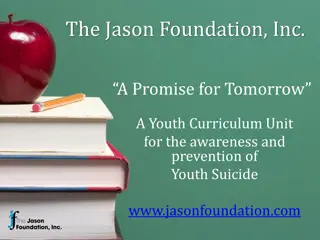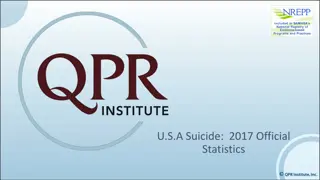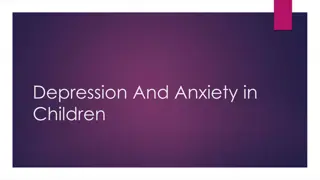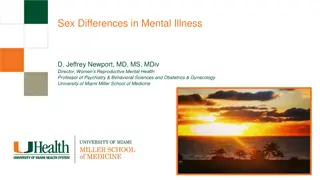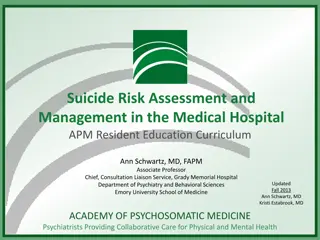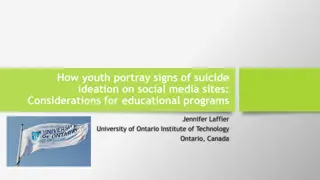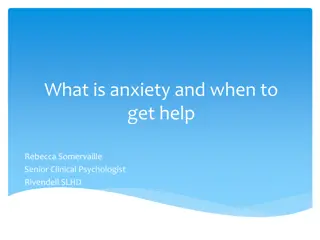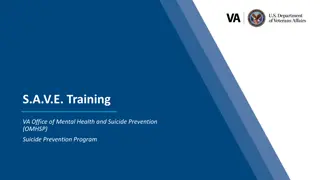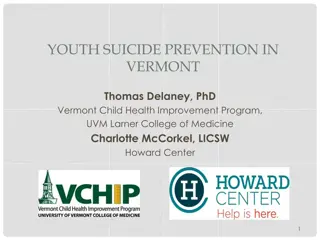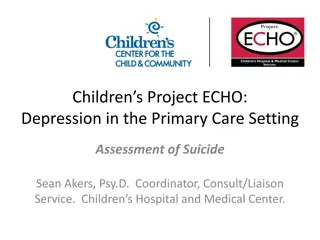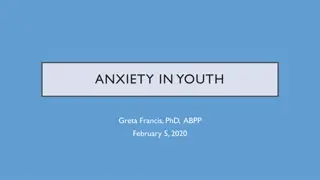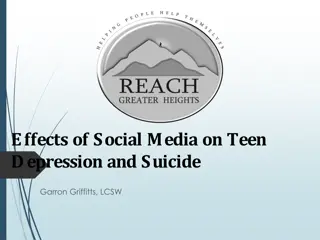Youth Mental Health: Understanding Anxiety, Depression, and Suicide
Anxiety, depression, and suicide are prevalent among children and youth, affecting their well-being, family dynamics, school performance, and social interactions. The co-occurrence of these mental health issues is common, with symptoms like stomachaches and headaches often present. Suicide ranks as a leading cause of death in young individuals, highlighting the importance of addressing mental health concerns early on to prevent tragic outcomes.
Download Presentation

Please find below an Image/Link to download the presentation.
The content on the website is provided AS IS for your information and personal use only. It may not be sold, licensed, or shared on other websites without obtaining consent from the author.If you encounter any issues during the download, it is possible that the publisher has removed the file from their server.
You are allowed to download the files provided on this website for personal or commercial use, subject to the condition that they are used lawfully. All files are the property of their respective owners.
The content on the website is provided AS IS for your information and personal use only. It may not be sold, licensed, or shared on other websites without obtaining consent from the author.
E N D
Presentation Transcript
ANXIETY, DEPRESSION, SUICIDE IN YOUTH: BIG PICTURE 7.1% of children aged 3-17 years (approximately 4.4 million) have diagnosed anxiety. 3.2% of children aged 3-17 years (approximately 1.9 million) have diagnosed depression.
ANXIETY, DEPRESSION, SUICIDE IN YOUTH: BIG PICTURE Anxiety & Depression commonly found together. Co-occurrence of different cognitive, emotional, behavioral disorders is the RULE not the exception. 2 symptoms often associated with these Stomachaches Headaches Irritability 2012 data, Centers for Disease Control
IMPACT Personal suffering Family suffering School attendance/performance Social, including more likely to be bullied Economic Health
LEADING CAUSES OF DEATH 10-14 years old 15-24 years old Unintentional Injuries (860) Suicide (520) Cancer (440) Congenital Abnormalities (190) Homicide (180) Unintentional Injuries (13,440) Suicide (6,250 Homicide (4900) Cancer (1370) Heart Disease (910)
LEADING CAUSES OF DEATH, AGE 15-19 All illnesses 27% Accidents 39% Homicide 15% Suicide 19%
Gender/Ethnicity, 15-19 18 15.5 16 14 12 9.1 10 8 5.5 6 3 4 2 0 WHITE MALES BLACK MALES WHITE FEMALES BLACK FEMALES
MOST COMMON METHOD Firearms 45-50%
IDEATION COMMUNICATION PLANNING ATTEMPTS DEATHS
R I S K F A C T O R S Demographic Clinical Family/Interpersonal
DEMOGRAPHICS Older people more than younger. Men more than women. White more than Black
R I S K F A C T O R S Demographic Clinical Family/Interpersonal
CLINICAL RISK FACTORS Psychiatric disorders Depression / Bipolar Alcohol / drug Conduct disorders PTSD Others: Anxiety, eating disorder, schizophrenia) Nonsuicidal Self-Injury
CLINICAL RISK FACTORS Learning Disorders Sleep Disturbance Discharged from Treatment LGBT with Distress/Non- acceptance
IF YOU ARE WITH A PERSON EXPERIENCING GREAT PSYCHOLOGICAL PAIN, WHO FEELS TRULY HOPELESS, YOU ARE IN THE ROOM WITH A SUICIDAL PERSON.
R I S K F A C T O R S Demographic Clinical Family/Interpersonal
FAMILY / INTERPERSONAL Family History of Psychiatric Illness and Suicide
FAMILY / INTERPERSONAL Family History of Psychiatric Illness and Suicide
FAMILY / INTERPERSONAL Sexual abuse (5-fold increase) Abuse / neglect Bullying (bullies AND victims) Poor peer relationships ( thwarted belongingness ) Poor family support, increased family conflict
FAMILY / INTERPERSONAL Sexual orientation & identity About 30% of LGBT youth attempt suicide at least once. Males>Females Exposure to suicidal behavior Access to firearms & other means
PROTECTIVE FACTORS FOR YOUTH Family connectedness School connectedness/Safe schools Mental health services Reduced access to firearms Academic Achievement
THE PROTECTIVE FACTORS IN ONE WORD connectedness
THE PROTECTIVE FACTORS IN ONE WORD belonging
SEEK HELP FOR YOURSELF AND ENCOURAGE IT FOR OTHERS




